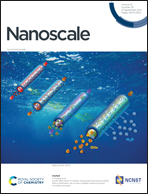Unexpected phosphorus doping routine of planar silicon nanowires for integrating CMOS logics†
Abstract
Complementary doping control in silicon nanowire (SiNW) channels is crucial for the construction of high-performance CMOS logics. Though planar in-plane solid–liquid–solid (IPSLS) growth, with an amorphous Si (a-Si) thin film as a precursor, has demonstrated a precise and scalable integration of orderly SiNWs, a complementary and tunable n-type doping has not been accomplished. This has been hindered by the fact that the phosphorus (P) gas dopants will react with the indium (In) catalyst droplet to form insoluble InP precipitates. Nevertheless, we herein report on an unexpected discovery that the P dopants first incorporated into the a-Si matrix can easily diffuse over the In catalyst droplets, without forming an InP compound, and thus reverse continuously the initial p-type SiNWs into an n-type channel. Uniform and efficient doping effects have been confirmed by both atomic probe tomography mapping and the transfer properties of SiNW FETs, which demonstrate a steep subthreshold swing of 105 mV dec−1, an on/off ratio of >107 and an electron mobility of 142 cm2 V−1 s−1. Finally, true CMOS inverters are successfully demonstrated based on the closely-packed SiNW channels of distinct doping polarities, indicating a new convenient and highly efficient doping routine to construct more advanced SiNW logics and sensors.



 Please wait while we load your content...
Please wait while we load your content...